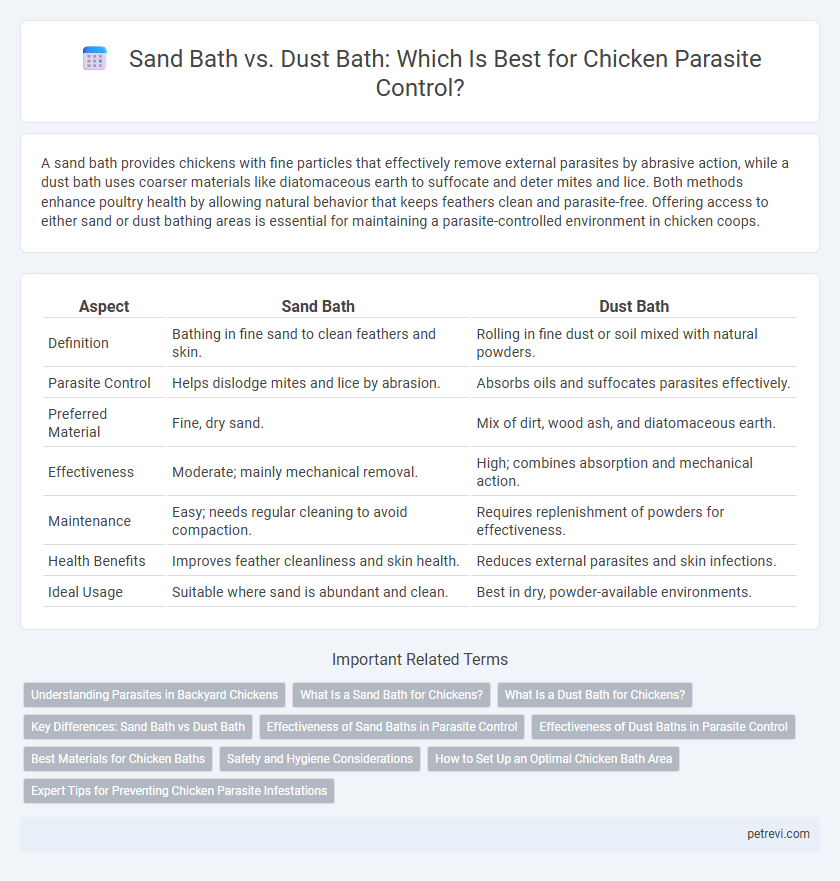A sand bath provides chickens with fine particles that effectively remove external parasites by abrasive action, while a dust bath uses coarser materials like diatomaceous earth to suffocate and deter mites and lice. Both methods enhance poultry health by allowing natural behavior that keeps feathers clean and parasite-free. Offering access to either sand or dust bathing areas is essential for maintaining a parasite-controlled environment in chicken coops.
Table of Comparison
| Aspect | Sand Bath | Dust Bath |
|---|---|---|
| Definition | Bathing in fine sand to clean feathers and skin. | Rolling in fine dust or soil mixed with natural powders. |
| Parasite Control | Helps dislodge mites and lice by abrasion. | Absorbs oils and suffocates parasites effectively. |
| Preferred Material | Fine, dry sand. | Mix of dirt, wood ash, and diatomaceous earth. |
| Effectiveness | Moderate; mainly mechanical removal. | High; combines absorption and mechanical action. |
| Maintenance | Easy; needs regular cleaning to avoid compaction. | Requires replenishment of powders for effectiveness. |
| Health Benefits | Improves feather cleanliness and skin health. | Reduces external parasites and skin infections. |
| Ideal Usage | Suitable where sand is abundant and clean. | Best in dry, powder-available environments. |
Understanding Parasites in Backyard Chickens
Parasite control in backyard chickens often involves sand baths and dust baths, each targeting different parasite types effectively. Dust baths, using fine particles like diatomaceous earth, are particularly effective against external parasites such as mites and lice by drying out their exoskeletons. Sand baths aid in cleaning feathers and removing larger debris but are less potent in directly controlling parasites compared to dust baths.
What Is a Sand Bath for Chickens?
A sand bath for chickens involves a shallow container or area filled with fine, dry sand where birds can roll and flap their wings to remove parasites like mites and lice. This method helps maintain feather health and reduces parasite infestations by dehydrating and dislodging pests from the skin and feathers. Sand baths provide a natural, low-maintenance solution that supports chickens' grooming behavior and overall wellbeing.
What Is a Dust Bath for Chickens?
A dust bath for chickens involves them flapping and rolling in loose, dry soil or fine dust to remove parasites like mites and lice from their feathers and skin. This natural behavior disrupts the life cycle of external parasites by suffocating and dislodging them while absorbing excess oil and moisture. Providing a designated dust bathing area with materials such as sand, wood ash, or diatomaceous earth enhances chicken health by promoting effective parasite control.
Key Differences: Sand Bath vs Dust Bath
Sand baths and dust baths are essential for chicken parasite control, with sand baths utilizing fine, moist sand to help chickens dislodge mites and lice through abrasive movements. Dust baths involve dry, loose materials such as wood ash, diatomaceous earth, or volcanic ash that absorb oils and suffocate parasites on the chicken's skin. Key differences lie in the moisture content--sand baths are slightly damp, enhancing exfoliation--while dust baths rely on dry particles for effective parasite deterrence.
Effectiveness of Sand Baths in Parasite Control
Sand baths are highly effective in controlling external parasites in chickens by allowing the birds to coat themselves with fine sand particles that suffocate mites and lice. The abrasive texture of sand helps dislodge and remove parasite eggs and larvae from the feathers and skin, reducing infestation levels. This natural behavior supports healthier plumage and decreases reliance on chemical treatments for parasite management.
Effectiveness of Dust Baths in Parasite Control
Dust baths are highly effective in controlling external parasites like mites and lice in chickens by suffocating and dislodging them from the feathers and skin. The fine particles in dust baths penetrate deep into feathers, reaching areas where parasites commonly hide, ensuring thorough parasite removal. Compared to sand baths, dust baths provide a natural and chemical-free method that enhances chicken health and reduces the risk of infestations.
Best Materials for Chicken Baths
Sand baths and dust baths are essential for chicken parasite control, using different materials that target mites and lice effectively. Fine sand or soft, clean dirt with minimal organic matter works best for sand baths, allowing chickens to scrape and clean their feathers deeply. For dust baths, diatomaceous earth or wood ash provide superior parasite control by absorbing oils and dehydrating pests without harming the chickens.
Safety and Hygiene Considerations
Dust baths provide a safer and more hygienic method for chickens to control parasites by allowing fine particles to penetrate feathers and skin, effectively dislodging mites and lice. Sand baths, though beneficial, may retain moisture and harbor harmful bacteria or parasites if not regularly cleaned, increasing health risks for the flock. Maintaining dry, clean dust or sand areas is crucial to prevent pathogen buildup and ensure effective parasite control.
How to Set Up an Optimal Chicken Bath Area
To set up an optimal chicken bath area for parasite control, create separate zones with fine, dry sand for sand baths and a mixture of dirt, wood ash, and sand for dust baths, ensuring both are located in shaded, well-drained spots to prevent moisture buildup and bacterial growth. Provide ample space--at least 3 square feet per chicken--allowing them to fully roll and flap for effective parasite removal. Regularly refresh the materials and maintain cleanliness to reduce parasite loads and promote healthy feather maintenance.
Expert Tips for Preventing Chicken Parasite Infestations
Sand baths and dust baths both play crucial roles in controlling chicken parasites by physically removing mites and lice from feathers and skin. Experts recommend using fine, dry sand mixed with diatomaceous earth for sand baths, which enhances parasite control through abrasive action and natural insecticidal properties. Regular access to dust bath areas with wood ash or loam also helps chickens maintain healthy plumage and reduces parasite infestations effectively.
Sand Bath vs Dust Bath for Chicken Parasite Control Infographic

 petrevi.com
petrevi.com